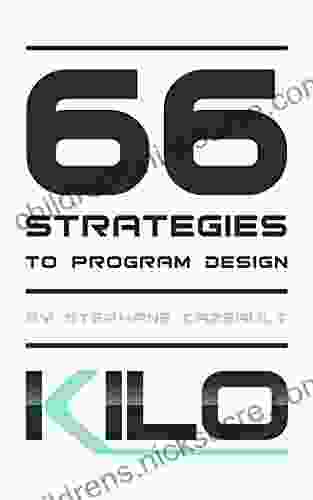66 Strategies To Program Design Stephane Cazeault

As an experienced program designer, I have witnessed firsthand the impact that strategic planning can have on the success of any program. Whether you are a seasoned professional or just starting out, incorporating these strategies into your program design approach can significantly enhance the quality and effectiveness of your programs.
4.8 out of 5
| Language | : | English |
| Text-to-Speech | : | Enabled |
| Enhanced typesetting | : | Enabled |
| Word Wise | : | Enabled |
| Print length | : | 154 pages |
| Lending | : | Enabled |
| File size | : | 599 KB |
| Screen Reader | : | Supported |
Understanding Program Design
Program design is the systematic process of planning, developing, implementing, and evaluating programs to meet specific needs and achieve desired outcomes. By following a well-defined design process, you can ensure that your programs are aligned with your mission, goals, and objectives.
Key Strategies for Effective Program Design
This comprehensive guide will explore 66 strategies that you can employ to strengthen your program design skills, categorized into six key phases:
- Planning
- Development
- Implementation
- Evaluation
- Communication
- Sustainability
1. Planning Phase
- Conduct a thorough needs assessment: Identify the gaps and unmet needs within the target population that your program aims to address.
- Define clear and measurable program goals and objectives: Articulate specific, attainable, relevant, and time-bound outcomes that your program will strive to achieve.
- Develop a comprehensive program logic model: Visualize the relationship between program activities, outputs, and expected outcomes.
- Identify target population and eligibility criteria: Determine the specific group of individuals or organizations that your program will serve.
- Conduct stakeholder analysis: Identify and engage key stakeholders who will be involved in or affected by your program.
- Develop an implementation plan: Outline the steps, resources, and timelines for implementing your program effectively.
- Create a budget: Estimate the financial resources needed to implement your program and identify potential funding sources.
- Secure necessary approvals: Obtain authorization and support from relevant authorities or governing bodies before implementing your program.
2. Development Phase
- Design program activities: Plan specific activities that will engage participants and facilitate the achievement of program goals.
- Develop program materials: Create manuals, curricula, assessments, and other resources to support program implementation and evaluation.
- Recruit and train staff and volunteers: Identify and prepare individuals who will be responsible for delivering your program.
- Establish partnerships and collaborations: Engage with other organizations and individuals to leverage resources and enhance program reach.
- Develop a monitoring and data collection plan: Outline the methods and systems for collecting data to track progress and measure outcomes.
- Pilot test your program: Conduct a small-scale trial run to assess feasibility, identify areas for improvement, and gather feedback.
- Incorporate feedback and make necessary adjustments: Gather and analyze feedback from pilot testing and make changes to your program design accordingly.
3. Implementation Phase
- Launch your program: Implement your program according to the established plan and secure stakeholder buy-in.
- Provide ongoing support to participants: Offer guidance, resources, and assistance to ensure participant engagement and success.
- Monitor program activities and collect data: Regularly track progress, identify challenges, and make adjustments as needed.
- Communicate with stakeholders: Keep stakeholders informed about program activities, outcomes, and any changes or updates.
- Facilitate participant feedback: Gather feedback from participants to gauge satisfaction, identify areas for improvement, and ensure program relevance.
4. Evaluation Phase
- Conduct formative evaluation: Regularly assess program implementation, identify areas for improvement, and make necessary adjustments.
- Conduct summative evaluation: Assess the overall effectiveness of your program and determine whether it achieved its intended outcomes.
- Use evaluation findings to inform future planning: Analyze evaluation results and use insights to improve future program designs.
- Disseminate evaluation findings: Share evaluation results with stakeholders to demonstrate program effectiveness and promote accountability.
- Incorporate evaluation findings into program improvement: Regularly review and update your program design based on evaluation findings to enhance its effectiveness.
5. Communication Phase
- Develop a communication plan: Outline strategies for disseminating information about your program and engaging with target audiences.
- Utilize multiple communication channels: Leverage various media, such as social media, email marketing, and print materials, to reach stakeholders.
- Tailor messaging to target audiences: Adapt communication content and language to resonate with specific stakeholder groups.
- Communicate program successes and outcomes: Share positive results, testimonials, and impact stories to demonstrate program effectiveness.
- Address negative feedback professionally: Respond to criticism or concerns in a timely and constructive manner.
6. Sustainability Phase
- Secure long-term funding: Identify and secure sustainable funding sources to ensure program continuity beyond initial funding.
- Develop a transition plan: Outline strategies for transitioning the program to new partners or organizations, if necessary.
- Build capacity within the community: Empower stakeholders with the knowledge and skills to sustain the program in the long run.
- Foster partnerships and collaborations: Engage with other organizations and individuals to support the program's mission and secure ongoing resources.
- Monitor and evaluate program sustainability: Regularly assess the program's financial health, stakeholder support, and community impact to ensure its long-term viability.
By incorporating these 66 strategies into your program design process, you can elevate the quality, effectiveness, and potential impact of your programs. Remember, program design is an iterative process that requires continuous improvement and adaptation. Embrace feedback, use data to inform decision-making, and remain passionate about making a positive difference in the lives of those you serve.
Follow these strategies and witness the transformative power of well-designed programs. Together, let's strive to create programs that empower individuals, strengthen communities, and contribute to a more just and equitable world.
4.8 out of 5
| Language | : | English |
| Text-to-Speech | : | Enabled |
| Enhanced typesetting | : | Enabled |
| Word Wise | : | Enabled |
| Print length | : | 154 pages |
| Lending | : | Enabled |
| File size | : | 599 KB |
| Screen Reader | : | Supported |
Do you want to contribute by writing guest posts on this blog?
Please contact us and send us a resume of previous articles that you have written.
 Fiction
Fiction Non Fiction
Non Fiction Romance
Romance Mystery
Mystery Thriller
Thriller SciFi
SciFi Fantasy
Fantasy Horror
Horror Biography
Biography Selfhelp
Selfhelp Business
Business History
History Classics
Classics Poetry
Poetry Childrens
Childrens Young Adult
Young Adult Educational
Educational Cooking
Cooking Travel
Travel Lifestyle
Lifestyle Spirituality
Spirituality Health
Health Fitness
Fitness Technology
Technology Science
Science Arts
Arts Crafts
Crafts DIY
DIY Gardening
Gardening Petcare
Petcare Oliver Horovitz
Oliver Horovitz Mark Bertin Md
Mark Bertin Md Tim Kimmel
Tim Kimmel Tahereh Mafi
Tahereh Mafi Rob Kelley
Rob Kelley Laurie Varga
Laurie Varga Laura M Ahearn
Laura M Ahearn J W Lynne
J W Lynne Paul Volponi
Paul Volponi Mark Mayfield
Mark Mayfield Darren Kirby
Darren Kirby Bookrags Com
Bookrags Com Myron Mixon
Myron Mixon Will Murray
Will Murray D J Taylor
D J Taylor Steph Davis
Steph Davis Jack O Connor
Jack O Connor Lin Lougheed
Lin Lougheed Kaylind Olson
Kaylind Olson Nicholaos Kehagias
Nicholaos Kehagias Chuck Robbins
Chuck Robbins Sadie Lake
Sadie Lake Kristen S Kurland
Kristen S Kurland Chris Townsend
Chris Townsend T Chris Riley Tillman
T Chris Riley Tillman Gina Atencio Maclean Psyd
Gina Atencio Maclean Psyd Ryan Tandler
Ryan Tandler James Nickells
James Nickells Eugene Hecht
Eugene Hecht Ray Walker
Ray Walker Gordon Forbes
Gordon Forbes John Novosel
John Novosel Remmi Smith
Remmi Smith Janet Patkowa
Janet Patkowa Lindsey Hutchinson
Lindsey Hutchinson Neil Smith
Neil Smith Cynthia Miller Idriss
Cynthia Miller Idriss Marke Bieschke
Marke Bieschke Paul Eng
Paul Eng Nick Clausen
Nick Clausen Frances Gies
Frances Gies Isla Gordon
Isla Gordon Cgp Books
Cgp Books Lisa Hoehn
Lisa Hoehn Wendy Moore
Wendy Moore Brian Smith
Brian Smith Dick Pobst
Dick Pobst Angelo Tropea
Angelo Tropea Susie Albert Miller
Susie Albert Miller Anita Knight Kuhnley
Anita Knight Kuhnley Helen Yang
Helen Yang Jeff Deters
Jeff Deters Jenna Tinsley
Jenna Tinsley Tracy Wolff
Tracy Wolff Sean Deveney
Sean Deveney L A Cotton
L A Cotton Paul Twitchell
Paul Twitchell Johnny Molloy
Johnny Molloy Paul Hough
Paul Hough Mark Wilson
Mark Wilson Magnus D Jango
Magnus D Jango Tyler Feder
Tyler Feder Justin Mcelroy
Justin Mcelroy Jan Witkowski
Jan Witkowski Jason Aaron
Jason Aaron Rae Brewer
Rae Brewer Pete Earley
Pete Earley Thomas Lewis
Thomas Lewis Don Jose Ruiz
Don Jose Ruiz Dick Crouser
Dick Crouser Josh Kaufman
Josh Kaufman J L Heilbron
J L Heilbron Michelle Hercules
Michelle Hercules Buster Holmes
Buster Holmes Stewart Pearce
Stewart Pearce Poul Anderson
Poul Anderson Karl Deisseroth
Karl Deisseroth Daniel Paolicchi
Daniel Paolicchi Tim Guest
Tim Guest Iain Mccalman
Iain Mccalman Alana Ash
Alana Ash Deborah J Bennett
Deborah J Bennett Martin L Kutscher
Martin L Kutscher Shannon Philpott Sanders
Shannon Philpott Sanders John J Kaag
John J Kaag Edward B Fiske
Edward B Fiske Christina Tosch
Christina Tosch Barry Correia
Barry Correia Stanley Vestal
Stanley Vestal James A Fain
James A Fain Steven Dillon
Steven Dillon Gavin Atkin
Gavin Atkin Govert Schilling
Govert Schilling Jessica Hall
Jessica Hall Lara Maiklem
Lara Maiklem Graham Allcott
Graham Allcott Imre Lakatos
Imre Lakatos Jada Fisher
Jada Fisher Mayur Movalia
Mayur Movalia J Budziszewski
J Budziszewski Tony Butt
Tony Butt Michael Easter
Michael Easter Joshua Straub
Joshua Straub Karen Lynch
Karen Lynch Eliot Cowan
Eliot Cowan John Heart
John Heart Rico Austin
Rico Austin Quinn Loftis
Quinn Loftis Tanya Holland
Tanya Holland Elisa S Amore
Elisa S Amore Julie Knutson
Julie Knutson Tabatha Chansard Phd
Tabatha Chansard Phd Aditya Chatterjee
Aditya Chatterjee Anja Beran
Anja Beran Daxton Wilde
Daxton Wilde Stephanie Garber
Stephanie Garber Emily R King
Emily R King David J Lieberman
David J Lieberman Dr Tracy Sanders
Dr Tracy Sanders Angie Papple Johnston
Angie Papple Johnston Kit Deslauriers
Kit Deslauriers Robert Jervis
Robert Jervis Tracy Salcedo
Tracy Salcedo Richard Karban
Richard Karban Nancy Ellen Abrams
Nancy Ellen Abrams Ray Bergman
Ray Bergman J M Adovasio
J M Adovasio Mia Collins Parker
Mia Collins Parker Guy Deutscher
Guy Deutscher Nouaoui Khedidja
Nouaoui Khedidja Rebecca Rolland
Rebecca Rolland Steven Cowie
Steven Cowie Julian Guthrie
Julian Guthrie Sankofa Ra
Sankofa Ra Donovan Buck
Donovan Buck Michael Harris
Michael Harris Val Waldeck
Val Waldeck Behrouz Moemeni
Behrouz Moemeni Brendan Leonard
Brendan Leonard Sherri Mitchell
Sherri Mitchell Samuel G Puryear
Samuel G Puryear Kate Bowler
Kate Bowler Cathy Glass
Cathy Glass Rachel Hartman
Rachel Hartman Dale Grdnic
Dale Grdnic Nick Schade
Nick Schade Alex Bonham
Alex Bonham David Poyer
David Poyer Felicity Aston
Felicity Aston Shane Frederick
Shane Frederick Jeremy Griffith
Jeremy Griffith Scott Keyes
Scott Keyes Jena Pincott
Jena Pincott Laurence Gonzales
Laurence Gonzales Doug Cook
Doug Cook Jean Molesky Poz
Jean Molesky Poz Vicki Lansky
Vicki Lansky Ichigo Takano
Ichigo Takano Frank Falcinelli
Frank Falcinelli John Frohnmayer
John Frohnmayer Emile Durkheim
Emile Durkheim Erling Kagge
Erling Kagge J M Gregson
J M Gregson John Brockman
John Brockman Paul Stewart
Paul Stewart Brook Waters
Brook Waters Marck Vaisman
Marck Vaisman Tom Mole
Tom Mole F C Yee
F C Yee John Feinstein
John Feinstein Larry Mueller
Larry Mueller Clinton Bailey
Clinton Bailey Eric Hanauer
Eric Hanauer M K Hume
M K Hume Jennifer Dugan
Jennifer Dugan Brian Burke
Brian Burke Yuri Kitayama
Yuri Kitayama Elissa Altman
Elissa Altman Kathy Borkoski
Kathy Borkoski Scott Haugen
Scott Haugen Simon Boulter
Simon Boulter R H Charles
R H Charles Gary Robert Muschla
Gary Robert Muschla Weston Ochse
Weston Ochse Marc Weissbluth M D
Marc Weissbluth M D Jimmy Song
Jimmy Song Jessica Redland
Jessica Redland Joy Bauer
Joy Bauer Brianna Madia
Brianna Madia John Krige
John Krige Douglas Turkington
Douglas Turkington Presh Talwalkar
Presh Talwalkar Beth Cavenaugh
Beth Cavenaugh Peter Liljedahl
Peter Liljedahl Patricia Ann Lynch
Patricia Ann Lynch Deborah Hunter Kells
Deborah Hunter Kells Gregory J Stewart
Gregory J Stewart David Deming
David Deming Tabatha Yeatts
Tabatha Yeatts Simon Winchester
Simon Winchester Angie Stanton
Angie Stanton Marley Hall
Marley Hall Kathy Fray
Kathy Fray Dr Gareth Moore
Dr Gareth Moore Tom Dokken
Tom Dokken Joe Fox
Joe Fox Daniel Harman
Daniel Harman George Hincapie
George Hincapie Peter Croker
Peter Croker Bruce Gregor Hodge
Bruce Gregor Hodge Jean Rose
Jean Rose Joan Didion
Joan Didion Darlene D Pedersen
Darlene D Pedersen Baby Professor
Baby Professor David Robert Grimes
David Robert Grimes Beth A Grosshans
Beth A Grosshans Brian Hayden
Brian Hayden Henry A Giroux
Henry A Giroux David Rakel
David Rakel Stan Lee
Stan Lee Mark Chang
Mark Chang Jeff A Johnson
Jeff A Johnson Erin Davis
Erin Davis Ania G
Ania G William S Frisbee Jr
William S Frisbee Jr Sharlene Healy
Sharlene Healy Frank Mastini
Frank Mastini Steph Jagger
Steph Jagger Mike Lowery
Mike Lowery Phil G Tang
Phil G Tang Felice Benuzzi
Felice Benuzzi Tyler Ninja Blevins
Tyler Ninja Blevins Evelyn Monahan
Evelyn Monahan Iri Cermak
Iri Cermak Jason Rosenhouse
Jason Rosenhouse Mary O Hora
Mary O Hora Sadie Word
Sadie Word J M Thompson
J M Thompson Bruce Feiler
Bruce Feiler Sara Zaske
Sara Zaske Vivienne Crow
Vivienne Crow Bob Stegner
Bob Stegner Jean Paul Pequegnot
Jean Paul Pequegnot Peter Galison
Peter Galison Nicholas Wade
Nicholas Wade Reed Mangels
Reed Mangels David M Gitlitz
David M Gitlitz Brent E Turvey
Brent E Turvey Ann Chamberlin
Ann Chamberlin Tommy Shea
Tommy Shea Chad Wesley Smith
Chad Wesley Smith Flor M Salvador
Flor M Salvador Terry Leiden
Terry Leiden Emiko Jean
Emiko Jean Kevin Callan
Kevin Callan Kenneth Wilgus Phd
Kenneth Wilgus Phd Dr Richard L Travis
Dr Richard L Travis Little Mat
Little Mat Terry Tempest Williams
Terry Tempest Williams Bruce Ackerberg
Bruce Ackerberg Grant Mcomie
Grant Mcomie Max Kuhn
Max Kuhn Sherman Dickinson
Sherman Dickinson Russ Mitchell
Russ Mitchell Deborah Reber
Deborah Reber Discover Press
Discover Press David E Maranz
David E Maranz Stephane Cazeault
Stephane Cazeault Anthony Castrovince
Anthony Castrovince Eric B Taylor
Eric B Taylor Norman Hall
Norman Hall Antonia Malchik
Antonia Malchik Persia Woolley
Persia Woolley Ann Douglas
Ann Douglas Hugh Harris
Hugh Harris Christina Mcghee
Christina Mcghee Sandra Steingraber
Sandra Steingraber Peter Lee
Peter Lee Eric Wargo
Eric Wargo William H Parker
William H Parker Ann Bingham
Ann Bingham Jim Grimsley
Jim Grimsley Joanna Nylund
Joanna Nylund Thomas Thompson
Thomas Thompson Sarah Pink
Sarah Pink Nikki Goth Itoi
Nikki Goth Itoi Angie Thomas
Angie Thomas Al Goldis
Al Goldis Jade Mckenzie Stone
Jade Mckenzie Stone Hippocrates
Hippocrates Elena Delle Donne
Elena Delle Donne Dan Hicks
Dan Hicks Frank X Sutman
Frank X Sutman Julie Gianelloni Connor
Julie Gianelloni Connor Sean Vigue
Sean Vigue Ava Richardson
Ava Richardson John Monyjok Maluth
John Monyjok Maluth Anil Ananthaswamy
Anil Ananthaswamy Michael Deshotels
Michael Deshotels Miyamoto Musashi
Miyamoto Musashi Julie Cwikla Phd
Julie Cwikla Phd Tina Payne Bryson
Tina Payne Bryson Steve Economides
Steve Economides Intisar Khanani
Intisar Khanani Dickie Bird
Dickie Bird Jenny Carr
Jenny Carr Ed Robinson
Ed Robinson David Roche
David Roche Natale Barca
Natale Barca Shonda Schilling
Shonda Schilling Melissa Watson
Melissa Watson Richard Paul Evans
Richard Paul Evans Comni S Art Publishing
Comni S Art Publishing Tennille Chaffin
Tennille Chaffin William Lee
William Lee Willie Mosconi
Willie Mosconi Joshua Slocum
Joshua Slocum Joe Shuber
Joe Shuber Chris Matakas
Chris Matakas Rc Blakes Jr
Rc Blakes Jr Philip P Massaro
Philip P Massaro Chris Dombrowski
Chris Dombrowski Richard Rorty
Richard Rorty Peter Julius Sloan
Peter Julius Sloan Robin Barrett
Robin Barrett Max M Houck
Max M Houck Peter Wacht
Peter Wacht Ann Mariah Cook
Ann Mariah Cook Caleb Lee
Caleb Lee Je Earl
Je Earl Richard Weaver
Richard Weaver Kristin Knight Pace
Kristin Knight Pace Robison Wells
Robison Wells Tami Oldham Ashcraft
Tami Oldham Ashcraft Katherine Nichols
Katherine Nichols Ann Imig
Ann Imig Elwyn Hayes
Elwyn Hayes Elizabeth G Harper
Elizabeth G Harper Ronald M Holmes
Ronald M Holmes Warren Berger
Warren Berger Charlene Beswick
Charlene Beswick Kamran Nazeer
Kamran Nazeer Edward O Thorp
Edward O Thorp Julius Evola
Julius Evola William J Ray
William J Ray Vera Snow
Vera Snow Bill Bishop
Bill Bishop Judy Goodspeed
Judy Goodspeed Fred Heath
Fred Heath Rick Clark
Rick Clark Wade Bourne
Wade Bourne Phoenix Nature
Phoenix Nature Wendy Mogel
Wendy Mogel Douglas Axe
Douglas Axe Emma Hansen
Emma Hansen Ann Bausum
Ann Bausum Brian Platzer
Brian Platzer Jim Burris
Jim Burris Cindy Hudson
Cindy Hudson Gail Carriger
Gail Carriger Shirley Maclaine
Shirley Maclaine Megan Hallett
Megan Hallett 2nd Edition Kindle Edition
2nd Edition Kindle Edition Ann Cook
Ann Cook Emily Teeter
Emily Teeter Sarah Albee
Sarah Albee James Campbell
James Campbell Jazmine Mccoy
Jazmine Mccoy Jody Vasquez
Jody Vasquez Ariel Dalfen
Ariel Dalfen Robert G Bugge
Robert G Bugge Kim Loraine
Kim Loraine Sara Dykman
Sara Dykman Robert H Shumway
Robert H Shumway Sherrie Eldridge
Sherrie Eldridge Namit Arora
Namit Arora Don Larsen
Don Larsen Paul Vachon
Paul Vachon Molly Harper
Molly Harper Judith A Muschla
Judith A Muschla Clayton Geoffreys
Clayton Geoffreys Katherine Keith
Katherine Keith Robin Esrock
Robin Esrock Dominique Pearson
Dominique Pearson Enrique Desmond Arias
Enrique Desmond Arias Helen Czerski
Helen Czerski Terry Hill
Terry Hill Beth Berry
Beth Berry Lisa Charlebois
Lisa Charlebois Laurie R King
Laurie R King Henny Bogan
Henny Bogan Marc Roche
Marc Roche Rachel Levin
Rachel Levin Wendy Lyons Sunshine
Wendy Lyons Sunshine Ben Magid
Ben Magid Sara Wolf
Sara Wolf James Freeman
James Freeman Shel Banks
Shel Banks Stu Ingraham
Stu Ingraham Bill Fowler
Bill Fowler Marissa Zwetow Lmft
Marissa Zwetow Lmft Shalane Flanagan
Shalane Flanagan Lisa Gardner
Lisa Gardner Sharon Cameron
Sharon Cameron Michael Kranish
Michael Kranish Ray Dozier
Ray Dozier Dr Mike Dilkes
Dr Mike Dilkes Damo Mitchell
Damo Mitchell Lindsey Fitzharris
Lindsey Fitzharris Bryson Payne
Bryson Payne David J Wallin
David J Wallin Emma Anne Bellamy
Emma Anne Bellamy Eric Alpenfels
Eric Alpenfels Sandra Cisneros
Sandra Cisneros Jon G Hughes
Jon G Hughes Sharon N Covington
Sharon N Covington Michael Yessis
Michael Yessis Dean Karnazes
Dean Karnazes Carl J Pratt
Carl J Pratt Jennifer Harvey
Jennifer Harvey Hunter S Fulghum
Hunter S Fulghum Peter Feinman
Peter Feinman Anjeanette Carter
Anjeanette Carter Susanne Elizabeth Freidberg
Susanne Elizabeth Freidberg Ron Rhodes
Ron Rhodes Ann Israel
Ann Israel Colin Rees
Colin Rees Kalman Samuels
Kalman Samuels Anita Biase
Anita Biase Imogen Barnacle
Imogen Barnacle John Romer
John Romer Benedict Go
Benedict Go Anita Cortez
Anita Cortez Oswald Rivera
Oswald Rivera Christof Koch
Christof Koch Robert Edelman
Robert Edelman Ann Cameron
Ann Cameron Bob Greene
Bob Greene Illustrated Edition Kindle Edition
Illustrated Edition Kindle Edition Waysun Liao
Waysun Liao Judy Cannato
Judy Cannato L R Shorter
L R Shorter Miles Cameron
Miles Cameron Mari Silva
Mari Silva Michael S A Graziano
Michael S A Graziano Martina Sprague
Martina Sprague Mary Helen Bowers
Mary Helen Bowers Sue C Funnell
Sue C Funnell Jerry C Whitaker
Jerry C Whitaker Duncan Van Dusen
Duncan Van Dusen Dale Peterson
Dale Peterson Victoria Clarke
Victoria Clarke Roasted Rat
Roasted Rat Sean Parker Dennison
Sean Parker Dennison Dorothy Roberts
Dorothy Roberts Scott Douglas
Scott Douglas Danielle Centoni
Danielle Centoni Julie Watson
Julie Watson Larry Greene
Larry Greene One Exam Prep
One Exam Prep Kumiko Makihara
Kumiko Makihara Carla Hall
Carla Hall Jeff Driscoll
Jeff Driscoll Ryan Boudreaux
Ryan Boudreaux Karen Jettmar
Karen Jettmar Rosanne S Mchenry
Rosanne S Mchenry Robert A Sadowski
Robert A Sadowski Susan Zimmermann
Susan Zimmermann Ann Leary
Ann Leary Sarah J Tracy
Sarah J Tracy Paul Fowler
Paul Fowler Benjamin T Mast
Benjamin T Mast Kevin Robbins
Kevin Robbins Ann Marie Brown
Ann Marie Brown Shannon Greenland
Shannon Greenland Michele Caputo
Michele Caputo Len Kravitz
Len Kravitz Art Clepper
Art Clepper Gary Sutherland
Gary Sutherland Michael Edelson
Michael Edelson Frederick Lewis Allen
Frederick Lewis Allen Becky Choi
Becky Choi Sharan B Merriam
Sharan B Merriam Elizabeth Wayland Barber
Elizabeth Wayland Barber Michael Harner
Michael Harner Stephen G Post
Stephen G Post Scholastic
Scholastic Tri Thong Dang
Tri Thong Dang Joshua Glenn
Joshua Glenn Janet Renner
Janet Renner Deena Kastor
Deena Kastor Lori Morrison
Lori Morrison Jack El Hai
Jack El Hai Tim Leffel
Tim Leffel Jane Goodall
Jane Goodall Nims Purja
Nims Purja Scott Cunningham
Scott Cunningham Jennie Germann Molz
Jennie Germann Molz Richard J Davidson
Richard J Davidson Elliott Mendelson
Elliott Mendelson Joshua Wright
Joshua Wright Johnegreek
Johnegreek Rebecca M Warner
Rebecca M Warner
Light bulbAdvertise smarter! Our strategic ad space ensures maximum exposure. Reserve your spot today!

 Jackson HayesPocket Psych Drugs: Point-of-Care Clinical Guide for Prescribers and Students
Jackson HayesPocket Psych Drugs: Point-of-Care Clinical Guide for Prescribers and Students Ricky BellFollow ·11.4k
Ricky BellFollow ·11.4k Fyodor DostoevskyFollow ·8.8k
Fyodor DostoevskyFollow ·8.8k Christopher WoodsFollow ·19.9k
Christopher WoodsFollow ·19.9k Ralph EllisonFollow ·12.3k
Ralph EllisonFollow ·12.3k Jaylen MitchellFollow ·8.4k
Jaylen MitchellFollow ·8.4k Elias MitchellFollow ·7.9k
Elias MitchellFollow ·7.9k Dylan HayesFollow ·15k
Dylan HayesFollow ·15k Vic ParkerFollow ·4.6k
Vic ParkerFollow ·4.6k

 Ernest J. Gaines
Ernest J. GainesMy Golf Blog Revolution: Open Stance
Are you ready to revolutionize your golf...

 Gene Powell
Gene PowellThe Unparalleled Genius of Calculus Volume Ichigo Takano:...
: The Birth of a...

 Edgar Hayes
Edgar HayesChild of the Northern Spring: A Journey of Discovery and...
In the heart of...

 Anthony Wells
Anthony WellsHybrid Aria: A Harmonious Blend of Modern Comfort and...
In the heart of a bustling...
4.8 out of 5
| Language | : | English |
| Text-to-Speech | : | Enabled |
| Enhanced typesetting | : | Enabled |
| Word Wise | : | Enabled |
| Print length | : | 154 pages |
| Lending | : | Enabled |
| File size | : | 599 KB |
| Screen Reader | : | Supported |














